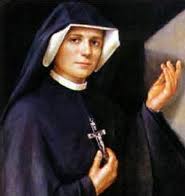
As Colleen’s first book became quite a point of discussion in various circles her professional opportunities increased exponentially. Soon she was offered a speech writing position in the George W. Bush administration. She left St. Louis to spend almost a year in Washington, DC. She says of this moment, when she was riding a wave of journalistic success which took her away from John and her home in St. Louis, “For the first time in my life, I felt sorry for my success” (65). But with John’s complete support she went to serve in the White House. (I will not give away much about her time there or her response to the people and events but it is well worth reading!)
Colleen now faced a new challenge–how to reconcile her desire for a prestigious career with her growing desire to marry John. The saint who helped her at this point was Maria Faustina Kowalska. 
One of the first great Catholics to discover Faustina, and thus help make her writing so widely popular, was Karol Wojtyla, who was of course the future Pope John Paul II. He discovered her writings living in Nazi-occupied Poland. John Paul’s favorite verse, used throughout his pontificate, was: “Be not afraid.” This reflected his desire to trust God’s providence, teaching that he had learned from the humble Faustina.
This underscores, for me at least, another aspect about the lives of the saints that Protestants find hard to understand. Saints are not “saviors.” They are not intermediaries. They are believers who lived well and whose lives show how to trust God and live faithfully. Faustina, for example, was a simple, humble woman with no real education. Yet her devotions have moved men and women to great depth and insights. (This is a lovely thing because it wonderfully illustrates the truth of 1 Corinthians 1:18-31). The depth of God’s love and grace is often revealed in the “weak things of this world” and the lives of the saints underscore this truth.
But what about the idea of saints and the teaching of the Catholic Church about them? First, I believe all true Christians are called “saints” in the New Testament (cf. 1 Cor. 1:2, 2 Cor. 1:1, Eph. 1:2, Phil. 1:1, Col. 1:2,etc.). The term itself is used as a virtual synonym for a Christian. Second, the word saint does not refer to some kind of specially holy person, but to all of those who seek holiness in Jesus Christ. But the unique use of saints as a title represents, in Catholicism, a “model” for all others. Think of them as “heroes” of the faith. The Catholic Church has an extensive process for “making saints” that I believe has no biblical or theological warrant but the end result is not, in itself, a negative. Further, the mystical experiences of many of these saints are not “meant to improve or complete Christ’s definitive revelation, but to help live more fully by it in a certain period of history” (Catechism of the Catholic Church, cited on page 69). Colleen writes of her “self-reliance and studied detachment” which had served her quite well in her “peripatetic childhood and compartmentalized college years” but when she embarked upon her White House year she needed someone to help her get through some major dilemmas. For her the answer was Faustina. She writes, “Her spirituality of trust would become an inspiration and a rebuke to me in the challenging days ahead” (71).
Related Posts
Comments
My Latest Book!

Use Promo code UNITY for 40% discount!






“–the word saint does not refer to some kind of specially holy person, but to all of those who seek holiness in Jesus Christ. But the unique use of saints as a title represents, in Catholicism, a “model” for all others. Think of them as “heroes” of the faith. The Catholic Church has an extensive process for “making saints” that I believe has no biblical or theological warrant but the end result is not, in itself, a negative.” Thank you John for clarifying the meaning ‘saints’
James H Kim liked this on Facebook.
LifeCoach Gwen Griffith liked this on Facebook.
I love her love story. She found a man who would love her and embrace her career and ambition as well.
Nick Morgan liked this on Facebook.